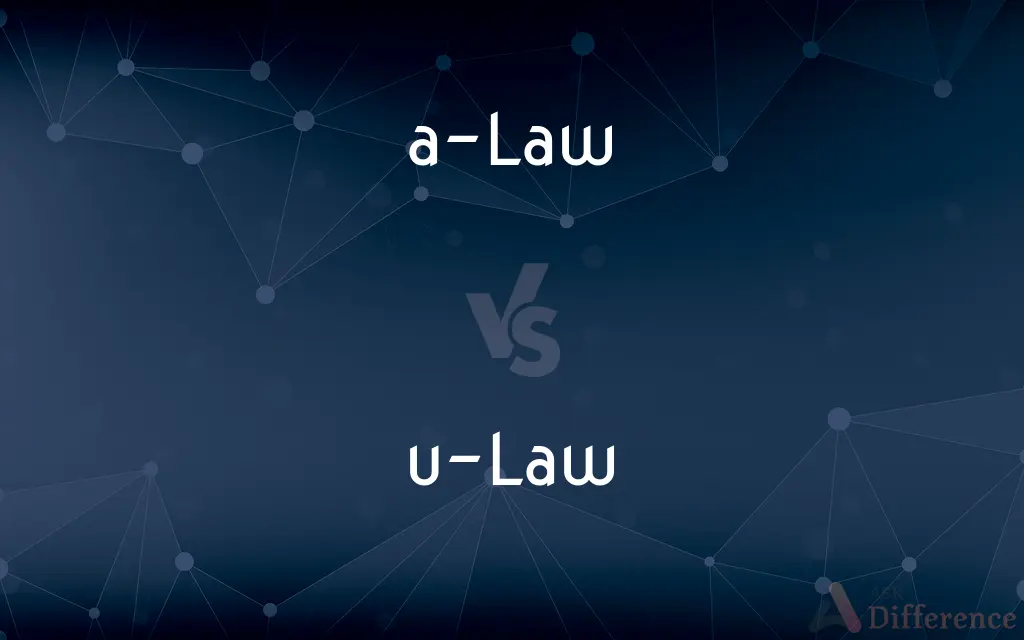a-Law vs. u-Law — What's the Difference?
By Tayyaba Rehman — Published on January 18, 2024
a-Law and u-Law are both audio companding algorithms; a-Law is used mainly in Europe and international systems, while u-Law is used primarily in North America and Japan.

Difference Between a-Law and u-Law
Table of Contents
ADVERTISEMENT
Key Differences
a-Law is an audio companding algorithm commonly used in European telecommunication systems. It is designed to optimize the dynamic range of an audio signal. Conversely, u-Law, used primarily in North America and Japan, is another companding algorithm that slightly differs in its approach to compressing audio signals.
8 compression ratio, while u-Law provides a 1:4 compression ratio, leading to variations in how audio signals are processed and reproduced.
The choice between a-Law and u-Law depends on regional standards and compatibility. a-Law is standardized in European countries, while u-Law is more prevalent in North American and Japanese telecommunications.
Regarding sound quality, the differences between a-Law and u-Law are subtle and mostly noticeable in professional audio processing or telecommunications. Both algorithms are effective in reducing the quantization noise in audio signals.
In application, both a-Law and u-Law are used in digital telephony systems to efficiently utilize bandwidth while maintaining audio quality. They are integral to the Pulse Code Modulation (PCM) process used in digital telecommunication systems.
ADVERTISEMENT
Comparison Chart
Region of Use
Mainly Europe and international systems
Primarily North America and Japan
Compression Ratio
1:8 compression ratio
1:4 compression ratio
Audio Processing
Slightly different compression curve
Different approach to compressing signals
Sound Quality
Subtle differences from u-Law
Subtle differences from a-Law
Application
Used in European digital telephony systems
Used in North American and Japanese systems
Compare with Definitions
a-Law
1:8 compression ratio
A-Law's 1:8 compression ratio optimizes our bandwidth usage.
u-Law
Audio signal processing
U-Law is effective in processing and compressing audio signals.
a-Law
European audio companding
Our system uses a-Law companding for audio in the European market.
u-Law
PCM application
In our Pulse Code Modulation process, u-Law is the preferred choice.
a-Law
Telecommunication standard
A-Law is the standard algorithm in our international telecom systems.
u-Law
Telecommunication algorithm
Our digital telephony systems use the u-Law algorithm.
a-Law
Dynamic range optimization
A-Law helps in optimizing the dynamic range of audio signals.
u-Law
1:4 compression ratio
U-Law utilizes a 1:4 compression ratio for audio signals.
a-Law
Used in PCM
In Pulse Code Modulation, we employ a-Law for audio compression.
u-Law
North American audio companding
We implement u-Law companding in our North American telecom network.
Common Curiosities
What is a-Law used for?
a-Law is used for audio companding in European telecommunication systems.
Where is u-Law predominantly used?
u-Law is mainly used in North American and Japanese telecommunication systems.
Which has a higher compression ratio, a-Law or u-Law?
a-Law has a higher compression ratio of 1:8 compared to u-Law's 1:4.
Do a-Law and u-Law affect sound quality?
Both algorithms maintain sound quality but have subtle differences in audio processing.
Are a-Law and u-Law interchangeable?
They are not interchangeable due to different regional standards and compression ratios.
Can a-Law be used in North America?
Technically yes, but u-Law is the standard in North America due to system compatibility.
Is u-Law better than a-Law?
"Better" depends on the specific requirements of the telecommunication system and region.
What is the purpose of using companding algorithms like a-Law and u-Law?
They are used to optimize the dynamic range of audio signals and reduce quantization noise.
Is a-Law suitable for international communications?
Yes, a-Law is commonly used in international telecommunication systems.
Are a-Law and u-Law used in mobile telephony?
Yes, they are used in digital mobile telephony for efficient audio data transmission.
How do a-Law and u-Law impact bandwidth usage?
Both algorithms efficiently utilize bandwidth while maintaining audio quality.
Can a-Law and u-Law be used in VoIP?
Yes, both are used in VoIP (Voice over Internet Protocol) systems for audio data compression.
Are there noticeable differences in audio quality between a-Law and u-Law?
Differences are subtle and mostly noticeable in professional audio processing or telecommunications.
What kind of systems use u-Law?
Digital telephony systems in North America and Japan typically use u-Law.
Do a-Law and u-Law require specific hardware?
They require compatible telecommunication systems and codecs to function correctly.
Share Your Discovery

Previous Comparison
Lufthansa vs. Qatar Airways
Next Comparison
Direct Material Cost vs. Indirect Material CostAuthor Spotlight
Written by
Tayyaba RehmanTayyaba Rehman is a distinguished writer, currently serving as a primary contributor to askdifference.com. As a researcher in semantics and etymology, Tayyaba's passion for the complexity of languages and their distinctions has found a perfect home on the platform. Tayyaba delves into the intricacies of language, distinguishing between commonly confused words and phrases, thereby providing clarity for readers worldwide.
















































